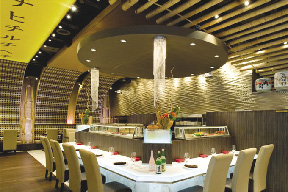Horst Design International, Cold Spring Harbor, LI, has recently designed this 3,200 s/f flagship dining facility located in the Tottenville neighborhood. In addition to developing a dramatic look, HDI was asked to gut and revamp the existing Lion's Den restaurant creating a sophisticated yet hip, comfortable dining environment.
According to owners Ray Tam & Fred Forte, the atmosphere is like "NYC's Soho meets Tokyo's Ginza District" - in a fast-paced contemporary Japanese restaurant. "The interior environment and food quality are light years ahead of other restaurants on the island)," said Forte.
"Customers view Takayama as a 'wow' space captivated by its 3D look," said Tam. "Whether you're in the sushi bar, main dining room or bar / lounge area that comprise the restaurant, there is always a special feature to capture your attention no matter which way you turn."
By overlapping several design elements, such as ceiling treatments or wall surfaces, HDI achieved openness, intimacy, depth and visual interest. Various materials are employed as screening type devices providing an intermediate visual surface that catches the light and stops the eye, but allows continual view of the space.
With a palette of soft tones and mostly neutral colored materials, HDI developed a clean, modern, high caliber interior that would appeal to an upscale mature customer.
Lighting also played a key role in this distinctive ambiance. "By creating a dramatically lit atmosphere that exudes both Asian & Western design influences, we generate greater visual interest and excitement," said Doug Horst, president, HDI.
At night, varying hued L.E.D. accent lights dramatically change the mood of the varying interior spaces including the sushi bar, main dining room and the bar/lounge area. A boldly backlit sushi bar is the grand visual focal point from the dining room & can even be seen thru the glass doors from outside the restaurant. The lighting throughout the space is both Halogen & L.E.D. sources in various forms ( track heads, strip lighting, recessed luminaries, cove lights, etc. - all dimmable & color changing at the press of a button).
Diners are greeted at the entry by an Asian inspired red-stone reception desk and a 35' long rear illuminated barrel vaulted bamboo ceiling treatment, which leads them into the central circulation space.
The main dining room is centrally situated with access to all other areas, including a set of large glass French doors leading to the patio dining area. Consisting of unique banquette seating that dramatically swoops up to form the ceilings, tasteful upholstery selections and carefully placed lighting - the main dining room provides a comfortable dining environment for all guests.
The bar/lounge is segregated - yet visible from the main dining room. Separated by a sexy golden strand-curtain wall & 12'-0" high upholstered arched banquettes, this area provides for stylish bar gatherings. Large screen plasma TV's entertain the guests, set against an illuminated wall of sculpted paper tiles. The translucent lamps overhead were designed to be the modern abstract version of the traditional shoji rice paper lamps.
HDI used many different types of materials from various European countries and throughout the U.S. For instance, the sushi bar is fabricated from a German translucent synthetic resin material that simulates Alabaster resembling a classy ice bar that you might find in Vegas. Other materials selected were string curtains from England, bamboo from Japan, tiles from Spain and Italy, to name a few.
For a hip "retro / cool" appearance, the entire bar top is fabricated from a Lava Lamp type material that is rear illuminated with energy efficient LED lighting and provides intriguing fluid type movement with the slightest touch on the bar top. The backwall behind the many sushi chefs is a shimmering wall of metallic sculpted panels that glisten in the soft halogen lighting.

Thanks for Reading!
You've read 2 of your 3 guest articles
Register and get instant unlimited access to all of our articles online.
Sign up is quick, easy, & FREE.
Subscription Options
Sign up is quick, easy, & FREE.
Already have an account? Login here







